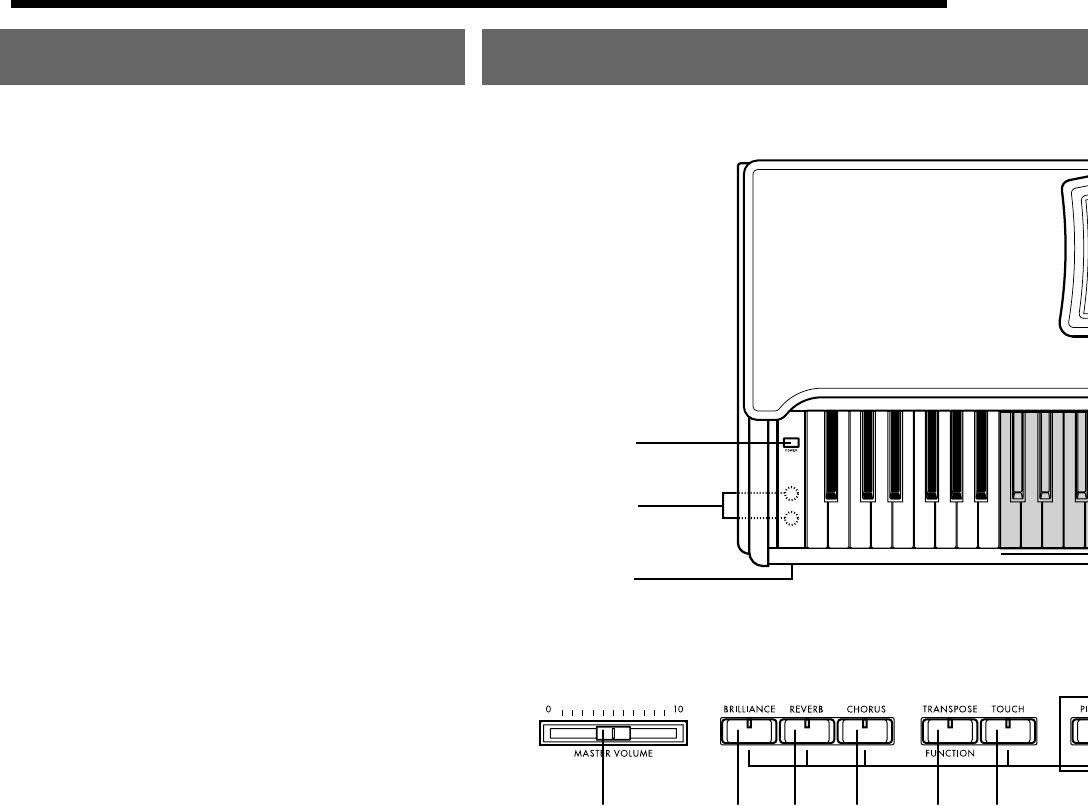
4
1
C
D
C1 C2
E
24 7635
Main features
A wide variety of sounds (☞p.11)
Six different expressive and high-quality sounds,
including a concert grand piano, are produced by
Korg's proprietary HI (Hyper Integrated) synthesis
system. You can use the Layer or Split functions to play
two sounds simultaneously.
Effects (☞p.11)
The C-4500 provides built-in digital effects that can
simulate the reverberation of a concert hall or add rich
spaciousness.
Pedal effects (☞p.12)
The C-4500 has the same three pedals as on an acoustic
piano: damper, sostenuto, and soft. The damper pedal
of the C-4500 also simulates the resonances that occur
in the strings of an acoustic piano. The damper pedal
and soft pedal allow half-pedaling techniques, where
the amount of effect can be adjusted by the depth with
which you press the pedal.
Metronome function (☞p.13)
The built-in metronome allows you to adjust the time
signature, tempo, and volume, and even use a bell
sound as the accent.
Recorder function (☞p.17)
The built-in recorder lets you record and play back your
performance as easily as when using a tape recorder.
Touch control function (☞p.14)
You can choose from three different settings to adjust
how the sound will respond to your keyboard playing
dynamics.
Temperaments (☞p.15)
In addition to equal temperament, the C-4500 allows
you to select two classical temperaments (Kirnberger
and Werckmeister) for historically accurate perfor-
mance of classical music.
Adjustable pitch (☞p.15)
The Transpose function lets you change the pitch of the
piano, and the Pitch Control function allows you to
make fine adjustments in the tuning.
MIDI capability (☞p.19)
The C-4500 supports MIDI, the standard that allows
musical data to be transferred between musical instru-
ments and computers. MIDI allows two or more
devices to control or be controlled by each other, and
also allows you to use the C-4500 as a 16-part multi-
timbral tone generator.
Parts of the C-4500 and their function
1 [POWER] switch
This switch turns the power on or off. Each time you
press it, the power will be turned on or off. (☞p.7)
2 [MASTER VOLUME] slider
This slider controls the volume that is output from the
speakers, headphones, and outputs. (☞p.7)
3 [BRILLIANCE] switch
This switch sets the brightness of the sound. (☞p.11)
4 [REVERB] switch
This switch applies reverberation to the sound (☞p.11).
5 [CHORUS] switch
This switch adds spaciousness to the sound (☞p.10).
6 [TRANSPOSE/FUNCTION] switch
This switch is used to make MIDI-related settings
(☞p.20), and to transpose the pitch (☞p.14). It is also
used to make various other settings.
7 [TOUCH] switch
This switch lets you select the keyboard touch. (☞p.14)


















